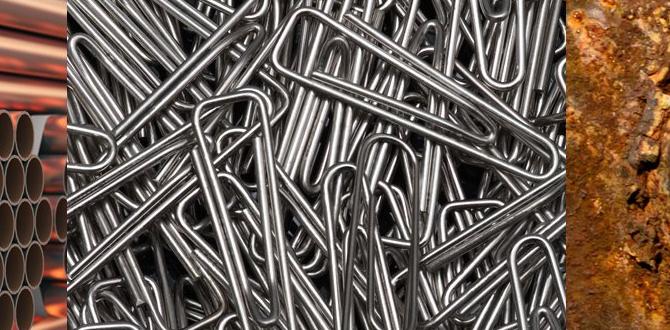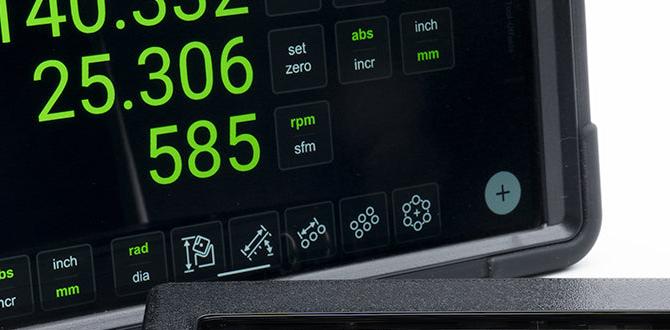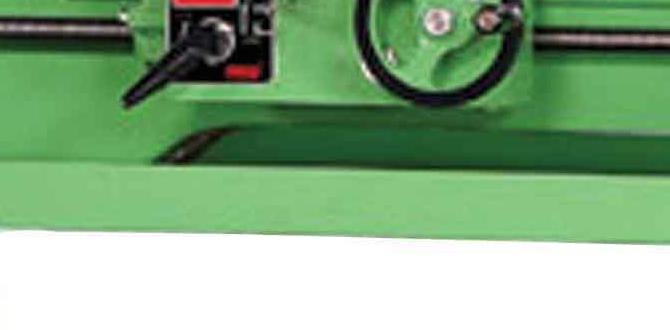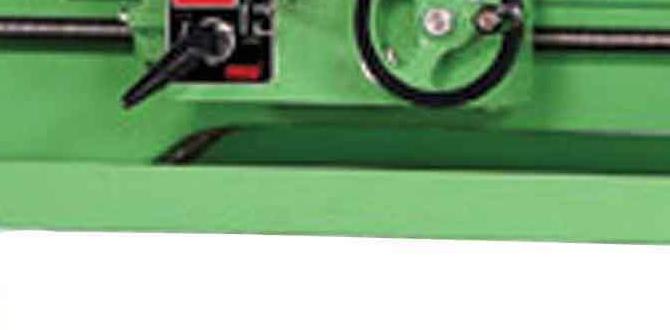DIY wood lathe faceplate screws setup: Essential Guide
Setting up your wood lathe faceplate screws correctly might seem a bit tricky at first. But don’t worry! It’s a fundamental skill that unlocks many exciting projects. This guide will walk you through every step. You’ll learn how to prepare your screws, your faceplate, and your lathe for safe and effective use. Let’s get your lathe ready for action!
Welcome to Lathe Hub! I’m Daniel Bates, and I love making tools and machines easy to understand. A wood lathe is a fantastic tool for creating beautiful things, but getting started with accessories like faceplates can feel a little daunting. You might look at it and wonder, “How do these screws even work?” or “Am I doing this right?” These are great questions! Many beginners feel the same way. The good news is that the process is straightforward when you break it down. We’ll go step-by-step, covering everything you need to know to get your faceplate screws set up safely and securely. By the end of this guide, you’ll feel confident and ready to tackle your first faceplate project!
Why Faceplate Screws Matter for Wood Turning
Faceplate screws are your direct link between your wood lathe and the workpiece you’re shaping. They are crucial for securely attaching larger, irregularly shaped pieces of wood to the lathe’s spindle. Think of bowls, platters, or even rough blanks for more complex turned items. Without a properly secured workpiece, you risk it flying off the lathe, which can be very dangerous. A good setup ensures stability, which directly translates to safer operation and better results. Proper screw placement and engagement prevent wobbling and ensure a smooth, controlled turning experience.
Understanding Your Wood Lathe Faceplate and Screws
Before we dive into the setup, let’s get familiar with the parts we’re working with. Your wood lathe faceplate is a metal disc that threads onto your lathe’s spindle. It provides a flat surface with pre-drilled and often tapped holes. These holes are where the faceplate screws go. The screws themselves are typically heavy-duty, often with a wide head, designed to grip the wood firmly. They come in various lengths and thread types, so it’s important to know what you have.
Types of Faceplates
Most wood lathes use a screw-on type faceplate. These thread directly onto the headstock spindle. They are generally made of cast iron or steel and come with a series of threaded holes around the perimeter and sometimes nearer the center. Some larger or specialized lathes might use a chuck with bolt-on jaws acting as a faceplate, but for this guide, we’ll focus on the traditional threaded faceplate.
Understanding Faceplate Screws
Faceplate screws are not your average wood screws. They are robust, designed for strength. You’ll usually find them with:
- Thick shanks to prevent bending under pressure.
- Large, flat heads to distribute force and provide a good bearing surface.
- Often, they have a coarse thread that bites well into wood.
It’s common to see faceplates with 3, 4, or even more screw holes. The number and arrangement depend on the faceplate’s size and design.
Essential Tools and Materials for Setup
To get your DIY wood lathe faceplate screws set up, you’ll need a few key items. Having them ready makes the process smooth and efficient.
What You’ll Need:
- Wood Lathe: The star of the show! Ensure it’s in good working order.
- Wood Lathe Faceplate: The correct size and thread for your lathe’s spindle.
- Faceplate Screws: Appropriate length and type for your project and faceplate.
- Workpiece: The piece of wood you intend to turn.
- Drill/Drill Press: For pre-drilling pilot holes.
- Drill Bits: Sized correctly as per the screw’s pilot hole recommendations (usually slightly smaller than the screw’s minor diameter).
- Screwdriver or Impact Driver: A sturdy one that fits the screw heads well.
- Measuring Tape or Ruler.
- Pencil or Marking Tool.
- Safety Glasses: Non-negotiable!
- Optional: Wood glue, clamps (if laminating pieces), workbench for preparation.
Step-by-Step Guide: Preparing Your Workpiece
The first and most critical part of setting up your faceplate screws is preparing the wood you’ll be attaching. This involves deciding where your screws will go and drilling pilot holes. This needs careful consideration for safety and stability.
Step 1: Selecting and Preparing Your Wood Blank
Choose a piece of wood that is suitably sized and shaped for your project. If you are turning a bowl, you might start with a round or slightly irregular chunk. For platters, a rectangular or oval blank works well. Ensure the wood is stable and free from major cracks or defects, especially in the areas where the screws will be inserted. If you’re laminating multiple pieces of wood to create a thicker blank, ensure they are glued and clamped securely before proceeding.
Step 2: Marking Screw Locations
This is where precision matters. We need to mark spots on the blank that are:
- Sufficiently far from the edges: To avoid splitting the wood.
- Into solid wood: Not into existing cracks or soft spots.
- Evenly spaced: For balanced turning.
A good rule of thumb is to place your screws at least 1.5 to 2 inches (38-50 mm) from the edge of the blank, depending on the wood’s hardness and the intended turning speed. For a typical faceplate with 4 screw holes, you’ll want to mark four spots that are roughly 90 degrees apart if viewed from the face. You can:
- Find the center of your blank (if you need to cut it to shape first).
- Mark out the diameter of your intended final piece.
- Using a compass or by measuring, mark lines that will dictate where your screws will eventually grip. These lines should generally be outside your finished design’s perimeter.
- Ensure each screw location is in a robust section of the wood. If you’re unsure, err on the side of caution and move the marks further out.
For very large or thin pieces, you might need to glue and screw backing blocks to the back of your blank. These blocks provide a more substantial area for the screws to grip, especially if the main blank material is too thin or prone to splitting.
Step 3: Drilling Pilot Holes
This is a critical step for safe and secure mounting. Drilling pilot holes prevents the wood from splitting when the faceplate screws are driven in. The size is important: too small, and you risk splitting; too large, and the screw won’t grip. A general guideline for pilot holes for wood screws is to drill a hole about 60-70% of the screw’s major diameter (the outside diameter of the threads). However, for faceplate screws, which are more robust, it’s often recommended to drill a hole that matches the screw’s minor diameter (the diameter at the bottom of the threads). This ensures the threads have maximum wood to bite into.
How to determine the pilot hole size:
- Consult Screw Packaging: Sometimes, the packaging will recommend a pilot hole size.
- Measure the Screw:
- Major Diameter: Measure the widest part of the screw, including the threads.
- Minor Diameter: Measure the narrowest part of the screw, at the bottom of the threads.
For faceplate screws, aim for a drill bit close to the minor diameter. You might need to experiment briefly on a scrap of the same wood.
Drilling:
- Use a drill press if possible for straighter holes. If using a hand drill, try to keep it as perpendicular to the wood surface as you can.
- Drill the holes to a depth slightly less than the length of the faceplate screw that will engage with the wood. You don’t want the screw tip to poke out the other side of your blank!
Step 4: Pre-drilling and Countersinking (Optional but Recommended)
For a flush fit, or if your faceplate has countersunk holes, you might need to countersink the pilot holes slightly. This creates a small cone-shaped depression for the screw head to sit in without protruding. However, many faceplate screws have flat heads, and the important part is getting good thread engagement.
Important Note on Spacing: If your faceplate has multiple screw holes, ensure your marked locations don’t interfere with each other. The screw heads need clearance to sit flush.
Step-by-Step Guide: Mounting the Faceplate
With your workpiece prepared, it’s time to attach the faceplate. This is where safety is paramount. Always ensure the lathe is off and unplugged during this process.
Step 1: Threading the Faceplate onto the Lathe Spindle
Make sure the faceplate’s internal thread matches your lathe’s spindle thread. They are usually clearly marked or can be found in your lathe’s manual. Clean both the spindle threads and faceplate threads if they appear dirty or rusty. Gently thread the faceplate onto the spindle by hand. Turn it clockwise until it is snug. Some woodturners add a dab of high-temperature grease or anti-seize compound to the threads for easier removal later, but this is optional.
Check for Spindle Thread Information:
| Lathe Spindle Thread Size (Common examples) | Faceplate Thread Size |
|---|---|
| 1″ x 8 TPI (Threads Per Inch) | 1″ x 8 TPI (Left or Right Hand) |
| 3/4″ x 10 TPI | 3/4″ x 10 TPI (Left or Right Hand) |
| M33 x 3.5 mm | M33 x 3.5 mm (Often Left Hand Thread) |
Note: Always confirm your specific lathe’s spindle thread size in its manual. TPI refers to the number of threads per inch.
Step 2: Positioning the Workpiece on the Faceplate
Place your prepared workpiece against the faceplate. Align the pre-drilled pilot holes in your workpiece with the tapped holes in the faceplate. You might need to rotate the spindle slightly by hand to get perfect alignment. Ensure the faceplate is flat against the wood surface you’re mounting it to.
Step 3: Inserting and Tightening the Faceplate Screws
Insert your faceplate screws into the aligned holes. Start by hand-tightening them. Once all screws are started, use your screwdriver or impact driver to tighten them. Tighten them in a star or cross pattern – similar to tightening lug nuts on a car wheel. This ensures even pressure distribution and prevents the workpiece from being pulled crookedly against the faceplate.
Tighten the screws firmly. They should be snug, but avoid over-tightening to the point where you strip the threads in the wood or the faceplate, or split the wood. The goal is to have the faceplate held securely and flat against the wood. A good connection means the wood will not shift or vibrate excessively during turning.
Step 4: Visual and Tactile Inspection
Once all screws are tightened, give everything a good visual check.
- Are the screw heads recessed or flush?
- Is the workpiece sitting flat against the faceplate?
- Are there any obvious gaps or signs of wood splitting?
Gently try to wiggle the workpiece. It should feel solid and immovable. If there’s any play, re-check the tightness of the screws.
Safety First! Crucial Precautions for Faceplate Turning
Woodturning, especially with faceplates and larger workpieces, demands a strong commitment to safety. Here are the absolute must-knows:
1. Always Wear Safety Glasses
This cannot be stressed enough. Wood chips and debris can fly off at high speeds. Your eyes are precious, so protect them.
2. Ensure the Lathe is Off and Unplugged
Never make adjustments, mount workpieces, or remove faceplates while the lathe is powered on. Double-check that it’s unplugged before you even touch the work or the faceplate.
3. Properly Prepare Your Wood
As we covered, well-placed, adequately sized pilot holes and solid wood are non-negotiable. Avoid turning on cracked or defect-ridden wood. Attach backing blocks if your primary blank is too thin or weak.
4. Correct Speed is Key
Start slow! For a new setup, especially with an unbalanced blank, begin at the slowest speed your lathe offers. Gradually increase the speed as you turn and the workpiece becomes more balanced and round. Consult your lathe’s manual for recommended speed ranges based on workpiece diameter. Larger diameters generally require slower speeds.
A useful resource for understanding turning speeds can be found on the Wood Turners Guild of Ontario Lathe Speed Chart. This chart provides guidance based on the diameter of your workpiece and wood type.
5. Use Adequate Screws and Pilot Holes
Don’t skimp on the number of screws or their quality. Ensure pilot holes are correctly sized. This is the primary point of failure if done incorrectly.
6. Secure Faceplate Installation
Make sure the faceplate is threaded on securely to the spindle. A loose faceplate is a recipe for disaster.
7. Keep Workspace Clean
A cluttered workspace is a dangerous workspace. Keep the area around your lathe clear of tools, scraps, and trip hazards.
8. Know Your Tool Rest Placement
Ensure your tool rest is positioned correctly – close to the workpiece but not touching, and at the correct height. This is vital for controlling your turning tools.
Troubleshooting Common Problems
Even with careful preparation, you might encounter a few snags. Here’s how to address them:
- Wood Splitting: This usually means the pilot hole was too small, or the wood itself was not strong enough. If minor, you might be able to use slightly longer screws or backing blocks. If severe, you may need to find a new piece of wood or a stronger section of the current one.
- Screw Won’t Tighten Fully: The pilot hole might be too large, or the wood might be too soft there. Try a slightly larger screw if possible, or consider using wood glue and sawdust to fill the hole and then re-drilling.
- Workpiece Wobbles: This can happen if the screws aren’t evenly tightened or the workpiece isn’t seated flat. Re-tighten screws in a star pattern. If the blank is inherently unbalanced, it will improve as you turn it round.
- Faceplate is Stuck: Sometimes, wood fibers can compress against the faceplate making it difficult to remove. You can try tapping the faceplate gently with a rubber mallet in a counter-clockwise direction. Ensure you’re turning the correct way for your lathe’s spindle thread (most are right-hand, but some are left-hand).
Frequently Asked Questions (FAQ)
Let’s cover some common beginner questions about DIY wood lathe faceplate screws setup.
Q1: What is the difference between a faceplate and a chuck?
A: A faceplate is a simple metal disc that threads onto the lathe spindle, providing screw holes for attaching workpieces directly. A chuck is a more versatile clamping device with jaws that can grip a drive spur, a tenon on the wood, or the inside/outside of a hollow form.
Q2: How do I know what thread size my lathe spindle is?
A: Check your lathe’s user manual. It’s the most reliable source. Common sizes include 1″ x 8 TPI, 3/4″ x 10 TPI, or metric sizes like M33 x 3.5. The size is usually stamped on the spindle itself or the gearbox housing.
Q3: Can I reuse faceplate screws?
A: Yes, you can reuse faceplate screws as long as they are not damaged, bent, or stripped. Inspect them for wear before each use.
Q4: What happens if I don’t drill pilot holes?
A: Not drilling pilot holes significantly increases the risk of splitting your wood, especially hardwoods or near the end grain. The screw will have difficulty engaging the wood fibers, leading to a weak and potentially dangerous attachment.
Q5: How deep should I drill the pilot holes?
A: Drill the pilot holes to a depth slightly less than the length of the screw that will engage with the wood’s threads. You want the screw to have good engagement





